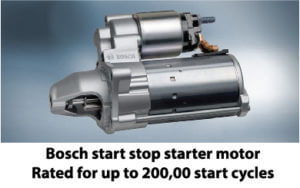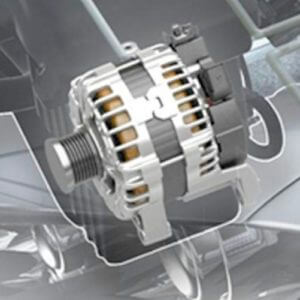All about cars with start stop systems
What are the pros and cons of a car with a start stop system?
Why have a start stop system?
The reason car makers are switching to start stop systems is simple; they save gas and car makers are desperate to improve their overall fleet MPG. It’s important to note however, that the EPA doesn’t include start stop systems when they calculate mileage rating. Those EPA MPG ratings are calculated with the start stop system disabled. However, starting with the 2017 model year, the EPA will begin issuing credits to car makers that incorporate start stop systems in their offerings. Car makers will also receive credits for using more efficient glass and aerodynamics.
How does a start stop system work?
Start stop systems (also called idle stop and idle stop and go) have been around since the 1990’s, mostly in hybrid vehicles. However, that’s changing rapidly. In fact, Ford reports that it expects 70% of its fleet to incorporate a start stop system by 2017. GM plans to incorporate start stop systems in at least one powertrain version on every model by 2020.
A start stop system shuts down the engine during periods of extended idling to save gas. How much gas does it save? That depends on the vehicle, but typically 3-12%. In an urban setting where the driver is engaged in stop and go driving, the savings can be as much as 10-12%. But there’s only minimal savings when the car is driven at highway speeds, for obvious reasons. Car makers are advertising start stop systems as saving around 6%. That’s a significant selling advantage, especially for truck and SUV buyers.
Start stop systems incorporate a heavy duty starter with a  projected life of over 200,000 starts versus a conventional starter that’s designed for a maximum of 40,000 starts. The cars also include a much more efficient absorbed glass mat (AGM) battery and even a second battery. They also include additional sensors, electric oil and coolant pumps.
projected life of over 200,000 starts versus a conventional starter that’s designed for a maximum of 40,000 starts. The cars also include a much more efficient absorbed glass mat (AGM) battery and even a second battery. They also include additional sensors, electric oil and coolant pumps.
Here’s the nitty-gritty on how start stop systems work:
The PCM continually monitors how you’re driving, taking into account engine speed, engine temperature and load, vehicle speed, brake and accelerator pedal positions, steering wheel position and transmission gear selection. The PCM also monitors electrical loads to determine whether you’re using headlights, wipers, AC, etc. Together with monitoring the current battery state of charge, the PCM can determine whether stopping the engine is the right move given the electrical load being used at the time.
The instant you take your foot off the accelerator, the PCM makes immediate decisions whether to stop the engine and when to do it. It may wait until the vehicle is motionless, or shut it down the instant your foot touches the brake pedal.
If the battery state of charge is less than 75%, the PCM will override the start stop system and prevent engine shutdown because it’s not convinced there’s enough power to run the electrical system while stopped and still have enough remaining power to restart the engine. This is especially true if the driver is using AC with high ambient outdoor temperatures, or defrosters and heat during winter conditions.
Most start stop systems use the starter motor to crank the engine on startup, although some car makers also use a two-way generator/starter to assist the starter.  Mazda’s “i-stop” system, for example, injects fuel into cylinders that are past top dead center on their power stroke and fires the spark plugs in those cylinders to give the engine and extra “kick” to speed up the start process and reduce starter motor load. Mazda reports that engine restart takes only 0.35-seconds in those engines.
Mazda’s “i-stop” system, for example, injects fuel into cylinders that are past top dead center on their power stroke and fires the spark plugs in those cylinders to give the engine and extra “kick” to speed up the start process and reduce starter motor load. Mazda reports that engine restart takes only 0.35-seconds in those engines.
The battery situation in start stop systems
Car makers never want to be in the position where they’ve shut off the engine with a battery that’s unable to restart the engine quickly. That’s why they’ve moved to more efficient AGM batteries. But these aren’t ordinary AGM starting batteries. They’re built with much more reserve capacity.
Other engine changes required due to start stop systems
As you know, start up is very hard on engines because there’s no oil pressure to separate engine components, so you get metal to metal contact. Imaging restarting an engine hundreds of times every day without oil pressure! To combat the extra wear, car makers install scuff-resistant friction reducing coatings on critical engine parts like bearings. The coatings provide a bit more protection until oil pressure can build. Some car makers are now considering an electrically driven oil pump to keep oil flowing during shutdown periods.
In addition, some car makers also incorporate electric cooling pumps to circulate engine coolant to maintain cabin heat in cold weather and prevent hot spots in the engine during shut down periods. Many hybrids use an electrical AC compressor to keep cabin temperatures comfortable while the engine is stopped.
Car makers also include voltage sensing modules to prevent voltage drops to the car’s electronics systems during the engine crank period. As you know, voltage drop can be significant during cranking. That voltage drop can cause “brownout” conditions for the vehicle many control modules, resulting in erratic operation when voltage drops below 9.6 volts. Voltage monitoring devices may shut down non-critical electrical accessories for an instant during start up to conserve power for the starter motor.
What goes wrong with start stop systems?
1) Stops but won’t start. This is certainly the worst case scenario and one car makers try to avoid by monitoring battery charge at all times. But a no-start condition can also be caused by a poor electrical connection, bad starter motor, bum alternator, damaged flywheel teeth or sensor failure. Any one of these could leave you stranded at a stop sign in stop and go traffic. Yikes!
2) Doesn’t stop when it should. Well, we can live with that, right? It’ll kill the gas mileage savings, but better a no-stop than a no-start.
Higher service costs for start stop systems?
You bet. AGM batteries for start stop systems are much more expensive than traditional flooded lead acid batteries or even typical starting AGM batteries. Be prepared to spend upwards of $300 or more when your AGM battery finally bites the dust. And, replacement isn’t as simple as swapping out the battery. The PCM and power management systems must be reprogrammed so they know a new battery is in place. That’s because the power management system constantly monitors the battery and adjusts charging rates and voltage based on the old battery’s condition. If you don’t reprogram the computer and simply install a new AGM battery, the power management system will continue to use the old charging protocol, possible ruining the new battery by overcharging it.
Starter motor replacement cost will also be a jolt to your wallet. Instead of costing around $300 to $400 for parts and labor, you’ll be spending closer to $1,000, especially in the early days when there won’t be a lot of rebuilt starter units available. Obviously as more vehicles are sold, the pool of rebuildable cores will grow and more rebuilt options will appear.
Then there’s the issue of additional engine wear. As I’ve already mentioned, car makers are coating bearing surfaces to reduce wear at startup. But that may not be enough to prevent premature engine failure. According to a recent article on Import-car.com, current motor oil testing doesn’t factor in the consequences of start stop systems and operation.
In a conventional engine without a start stop system, the 20,000 to 40,000 starts it will encounter in its lifetime accounts for up to 75% of all engine wear. Start stop systems increase starting cycles tenfold if the owner drives in stop and go traffic. That can cut bearing life in half. Most wear will occur at camshaft, balance shaft, main and connecting bearings, as well as wrist pins. To combat this wear, Jaguar has moved to roller bearings for their camshaft and balance shafts in the Ingenium model. As I mentioned earlier, you can also expect car makers to add electric oil pumps.
Car makers are also working with oil manufacturers to modify motor oil to incorporate “gel-forming superlubricity additives (SLA).” These additives can double oil film strength and prevent the oil film from collapsing during shut down phases.
Can you shut off the start stop system?
Yes, but only temporarily. The start stop system will activate again the next time you insert the key and start the engine.
Do drivers like start stop systems?
Not really. In a recent New York Times article, reporter Eric Taub interviewed one driver who hates the start stop system in his Mercedes.
“The problem, Dr. Tao says, is that the stopping and restarting is rather intrusive. “You actually feel it restarting,” he said. “In terrible stop-and-go traffic this thing comes on and off constantly. In 20 minutes you can have 50 stop-and start cycles. It can drive you totally insane.” New York Times 4/7/16
©, 2016 Rick Muscoplat
Posted on by Rick Muscoplat
